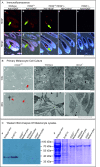Overexpression of hepatoma-derived growth factor in melanocytes does not lead to oncogenic transformation
- PMID: 22014102
- PMCID: PMC3213223
- DOI: 10.1186/1471-2407-11-457
Overexpression of hepatoma-derived growth factor in melanocytes does not lead to oncogenic transformation
Abstract
Background: HDGF is a growth factor which is overexpressed in a wide range of tumors. Importantly, expression levels were identified as a prognostic marker in some types of cancer such as melanoma.
Methods: To investigate the presumed oncogenic/transforming capacity of HDGF, we generated transgenic mice overexpressing HDGF in melanocytes. These mice were bred with mice heterozygous for a defective copy of the Ink4a tumor suppressor gene and were exposed to UV light to increase the risk for tumor development both genetically and physiochemically. Mice were analyzed by immunohistochemistry and Western blotting. Furthermore, primary melanocytes were isolated from different strains created.
Results: Transgenic animals overexpressed HDGF in hair follicle melanocytes. Interestingly, primary melanocytes isolated from transgenic animals were not able to differentiate in vitro whereas cells isolated from wild type and HDGF-deficient animals were. Although, HDGF-/-/Ink4a+/- mice displayed an increased number of epidermoid cysts after exposure to UV light, no melanomas or premelanocytic alterations could be detected in this mouse model.
Conclusions: The results therefore provide no evidence that HDGF has a transforming capacity in tumor development. Our results in combination with previous findings point to a possible role in cell differentiation and suggest that HDGF promotes tumor progression after secondary upregulation and may represent another protein fitting into the concept of non-oncogene addiction of tumor tissue.
Figures




Similar articles
-
Up-regulation of hepatoma-derived growth factor facilitates tumor progression in malignant melanoma [corrected].PLoS One. 2013;8(3):e59345. doi: 10.1371/journal.pone.0059345. Epub 2013 Mar 25. PLoS One. 2013. PMID: 23536873 Free PMC article.
-
Expression of hepatoma-derived growth factor in hepatocellular carcinoma.Cancer. 2003 Oct 1;98(7):1444-56. doi: 10.1002/cncr.11653. Cancer. 2003. PMID: 14508832
-
Insights into developmental mechanisms and cancers in the mammalian intestine derived from serial analysis of gene expression and study of the hepatoma-derived growth factor (HDGF).Development. 2005 Jan;132(2):415-27. doi: 10.1242/dev.01579. Epub 2004 Dec 16. Development. 2005. PMID: 15604097
-
Hepatoma-Derived Growth Factor: Its Possible Involvement in the Progression of Hepatocellular Carcinoma.Int J Mol Sci. 2015 Jun 19;16(6):14086-97. doi: 10.3390/ijms160614086. Int J Mol Sci. 2015. PMID: 26101867 Free PMC article. Review.
-
Hepatoma-Derived Growth Factor: An Overview and Its Role as a Potential Therapeutic Target Molecule for Digestive Malignancies.Int J Mol Sci. 2020 Jun 13;21(12):4216. doi: 10.3390/ijms21124216. Int J Mol Sci. 2020. PMID: 32545762 Free PMC article. Review.
Cited by
-
Recurrent co-alteration of HDGF and SETDB1 on chromosome 1q drives cutaneous melanoma progression and poor prognosis.Pigment Cell Melanoma Res. 2021 May;34(3):641-647. doi: 10.1111/pcmr.12937. Epub 2020 Nov 17. Pigment Cell Melanoma Res. 2021. PMID: 33064882 Free PMC article.
-
CIB1: a small protein with big ambitions.FASEB J. 2016 Aug;30(8):2640-50. doi: 10.1096/fj.201500073R. Epub 2016 Apr 26. FASEB J. 2016. PMID: 27118676 Free PMC article. Review.
References
-
- Nakamura H, Izumoto Y, Kambe H, Kuroda T, Mori T, Kawamura K, Yamamoto H, Kishimoto T. Molecular cloning of complementary DNA for a novel human hepatoma-derived growth factor. Its homology with high mobility group-1 protein. J Biol Chem. 1994;269(40):25143–25149. - PubMed
MeSH terms
Substances
LinkOut - more resources
Full Text Sources
Molecular Biology Databases

